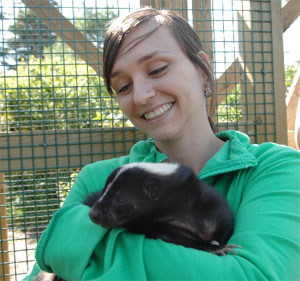 |
| Meredith Brison-Brown and educational animal Julie, the skunk, at Hope for Wildlife, a wildlife rehabilitation facility. (Danny Abriel Photo) |
As Meredith Brison-Brown cradles the skunk in her arms, her mothering skills come naturally. Without realizing it, she starts to rock her black-and-white striped bundle.
“Honestly,” she says as she puts the year-old animal back on the ground and it waddles back toward the shade, “the hardest part of the job is staying away on my days off.”
The Dalhousie student is wrapping up an internship at the Hope for Wildlife Centre, located in Seaforth, on Nova Scotia’s eastern shore. Between the buses and transfers, it takes her two and a half hours to make the trip from her Halifax home, but every moment is worth it.
SEE PHOTO ESSAY: A story of hope by Danny Abriel
The wildlife rehabilitation, education and research facility was established in 1997 by Hope Swinimer. More than 1,200 birds and mammals are brought to the centre each year and cared for until they’re well enough to be returned to the wild. Others, like exotic animals or native animals with injuries too severe to make survival in the wild likely, find permanent homes at the centre.
Like Julie, the skunk. The gentle creature was brought to the centre as the only survivor of a large litter that was stoned to death.
Now an “educational animal” (its musk glands have been removed), Julie was one of the star attractions of the centre’s open house last Sunday. Open houses provide an opportunity for the public to learn about co-existing peacefully with wildlife while acting as fundraisers. While the centre gets some corporate sponsorship from companies like TD, Home Depot and Shell and government grants, money is always tight. "We spend a fortune in mice, crickets and mealworms," explains Ms. Swinimer.
There’s a lot to see at the facility, located on a 100-acre property overlooking the ocean, from the learning centre, the pollinator flower garden (complete with beehive) and flight cage, currently the home of a pair of injured Great Horned Owls and three Bald Eagles.
“With my degree, I have been studying the effects of development on the natural world in the hopes of finding ways to reduce our negative impact,” explains Ms. Brison-Brown, a third-year student in International Development Studies and Environmental Studies at Dalhousie. “This internship has given me the opportunity to see first hand some of those impacts and some of the ways we can mitigate them.”
Many of the animals arrive at the centre having survived a run-in with the human species. There are turtles with cracked shells that have been run over on roads, birds that have collided with windows, gulls covered in bunker sea oil. And there are many babies: fawns that were born after their mothers were hit by cars and raccoon kits orphaned after their mothers were trapped and sent away.
Other animals at the centre don't really belong in Canada at all—like the pair of sugar gliders, small flying marsupials native to Australia, New Zealand and New Guinea; an endangered Greek Spur Tortoise from Africa that someone tried to smuggle into the country; and Topaz, an Amazon Parrot that arrived after its owner died.
“Some animals are not meant to be pets,” says centre staffer Allison Dubé, who graduated with a biology degree from Dalhousie last year. She’s holding the sugar gliders in a colourful knitted tuque which acts as their makeshift den.
“Cute as they are, they are really wild animals in cages. They should be gliding around in a big forest somewhere. So we also like to talk to people about being responsible pet owners.”
LINK: Hope for Wildlife
IN THE NEWS: Sweet skunk steals society's show
